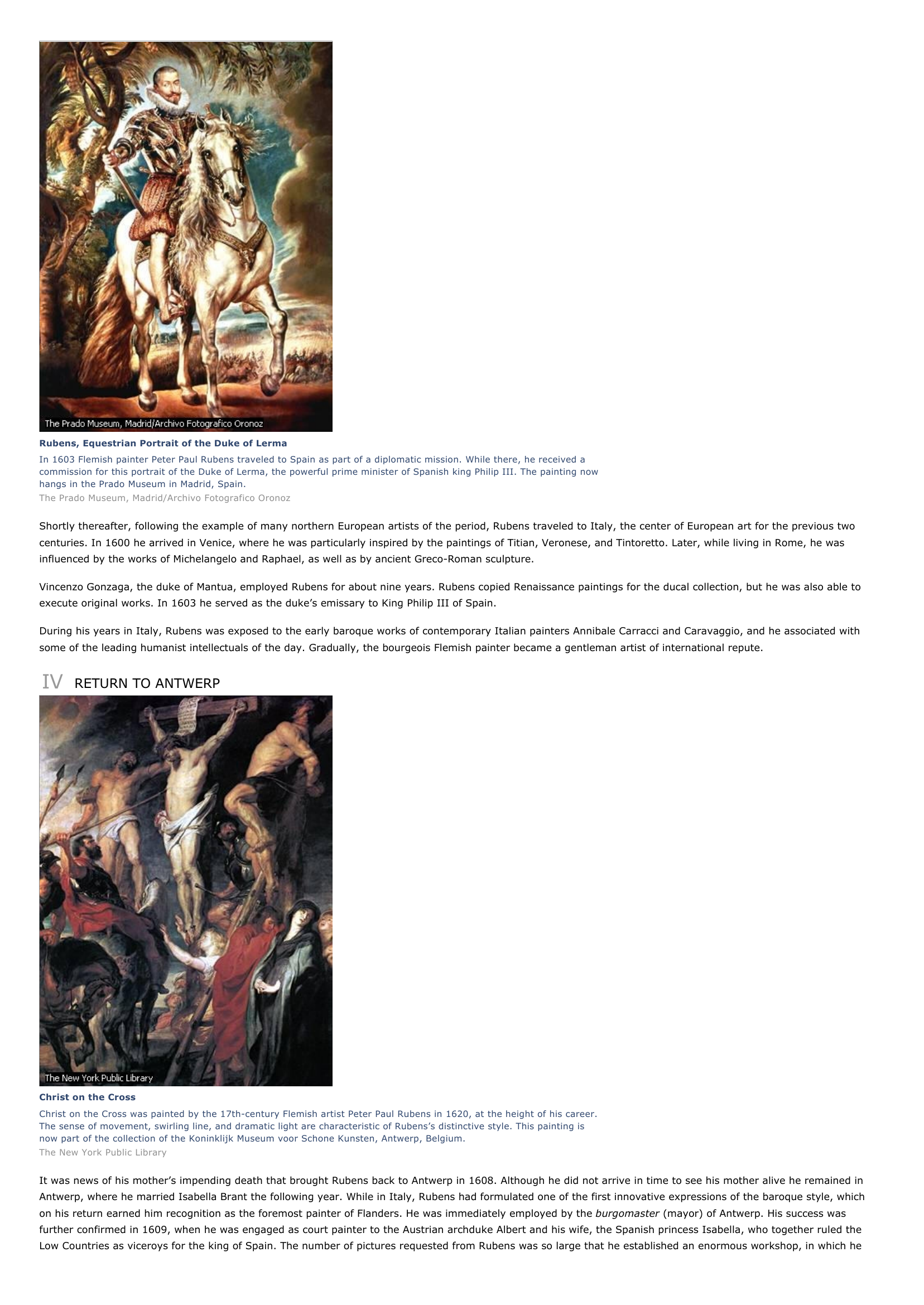Peter Paul Rubens I INTRODUCTION Thetis Dipping Achilles in the Styx The sea nymph Thetis is seen dipping her son Achilles in the River Styx to make him immortal.
Publié le 12/05/2013

Extrait du document
«
Rubens, Equestrian Portrait of the Duke of LermaIn 1603 Flemish painter Peter Paul Rubens traveled to Spain as part of a diplomatic mission.
While there, he received acommission for this portrait of the Duke of Lerma, the powerful prime minister of Spanish king Philip III.
The painting nowhangs in the Prado Museum in Madrid, Spain.The Prado Museum, Madrid/Archivo Fotografico Oronoz
Shortly thereafter, following the example of many northern European artists of the period, Rubens traveled to Italy, the center of European art for the previous twocenturies.
In 1600 he arrived in Venice, where he was particularly inspired by the paintings of Titian, Veronese, and Tintoretto.
Later, while living in Rome, he wasinfluenced by the works of Michelangelo and Raphael, as well as by ancient Greco-Roman sculpture.
Vincenzo Gonzaga, the duke of Mantua, employed Rubens for about nine years.
Rubens copied Renaissance paintings for the ducal collection, but he was also able toexecute original works.
In 1603 he served as the duke’s emissary to King Philip III of Spain.
During his years in Italy, Rubens was exposed to the early baroque works of contemporary Italian painters Annibale Carracci and Caravaggio, and he associated withsome of the leading humanist intellectuals of the day.
Gradually, the bourgeois Flemish painter became a gentleman artist of international repute.
IV RETURN TO ANTWERP
Christ on the CrossChrist on the Cross was painted by the 17th-century Flemish artist Peter Paul Rubens in 1620, at the height of his career.The sense of movement, swirling line, and dramatic light are characteristic of Rubens’s distinctive style.
This painting isnow part of the collection of the Koninklijk Museum voor Schone Kunsten, Antwerp, Belgium.The New York Public Library
It was news of his mother’s impending death that brought Rubens back to Antwerp in 1608.
Although he did not arrive in time to see his mother alive he remained inAntwerp, where he married Isabella Brant the following year.
While in Italy, Rubens had formulated one of the first innovative expressions of the baroque style, whichon his return earned him recognition as the foremost painter of Flanders.
He was immediately employed by the burgomaster (mayor) of Antwerp.
His success was further confirmed in 1609, when he was engaged as court painter to the Austrian archduke Albert and his wife, the Spanish princess Isabella, who together ruled theLow Countries as viceroys for the king of Spain.
The number of pictures requested from Rubens was so large that he established an enormous workshop, in which he.
»
↓↓↓ APERÇU DU DOCUMENT ↓↓↓
Liens utiles
- Achilles I INTRODUCTION Thetis Dipping Achilles in the Styx The sea nymph Thetis is seen dipping her son Achilles in the River Styx to make him immortal.
- Peter Paul Rubens : Portrait de Suzanne Fourment
- Peter Paul Rubens - KUNSTLER.
- Latium Roman In ancient times, a region in west-central Italy, south and east of the Tiber River on the shores of the Tyrrhenian Sea.
- Medusa Greek One of the three Gorgons, the only one who was not immortal; her sisters were Stheno and Euryale.










